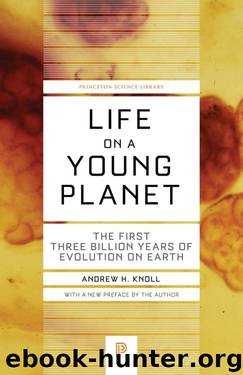Life on a Young Planet: The First Three Billion Years of Evolution on Earth: The First Three Billion Years of Evolution on Earth (Princeton Science Library) by Andrew H. Knoll

Author:Andrew H. Knoll [Knoll, Andrew H.]
Language: eng
Format: epub
Publisher: Princeton University Press
Published: 2015-03-21T22:00:00+00:00
Figure 9.2. A spiny microfossil found commonly in Doushantuo cherts and phosphatic rocks. Such fossils are thought to be the reproductive spores of eukaryotic organisms. Fossil is 250 microns in diameter. (Image courtesy of Shuhai Xiao)
The Maiohe fossils were preserved by rapid burial in fine-grained sediment. Bacteria normally decompose algal tissues soon after death, but at Maiohe they were prevented from completing this task by a veneer of clay that both excluded oxygen and adsorbed the enzymes that break cells apart. As sedimentary layers accumulated, biological remains were pressed like flowers between the pages of a book.
Leaves are commonly compressed in younger mudstones formed in lakes or the floodplains of rivers. In marine rocks, however, organic compressions are rare because burrowing animals irrigate and churn mud and silt layers. Rare, but not unknown. In fact, the most famous of all fossil deposits, the Middle Cambrian Burgess Shale, formed by the compression of animal carcasses in carbon-rich mudstones.4 Burgess fossils postdate Doushantuo deposition by only 50–85 million years; thus, the Doushantuo compressions are noteworthy for what they lack as well as what they include. One population of flanged tubes may record simple, sea anemone–like invertebrates (plate 5b), but nowhere do we find evidence of the anatomically and morphologically complex animals that are so conspicuous in Burgess and other Cambrian glimpses through the same preservational window. Evidently, much happened between Doushantuo and Burgess time.
I became involved in the study of Doushantuo fossils at the invitation of Professor Zhang Yun, a kind, cultured, and wonderfully insightful paleontologist at Beijing University. During the 1980s, Zhang collected Doushantuo samples from a phosphate mine near the Guizhou village of Weng’an. Several contained multicellular algae. In 1992, to my everlasting good fortune, he asked me to join him in collaborative research. By coincidence, a second Chinese friend, Yin Leiming of the Nanjing Institute of Geology and Palaeontology, invited me to visit China at about the same time. Yin was working on Doushantuo fossils in cherts from the Yangtze Gorges and Zhang was investigating assemblages from the phosphate mines of Guizhou, so I suggested that the three of us join forces to try to understand the full diversity of Doushantuo eukaryotes. Shuhai Xiao, who had completed his bachelor’s degree in Beijing under Zhang’s guidance, entered Harvard as a graduate student the same year, completing our team.
Doushantuo cherts and shales open two distinct and unusually clear windows on late Proterozoic life, but those Guizhou phosphates provide a third view, even better than the others. In this corner of the shallow Doushantuo seaway, biological remains that entered surface sediments were coated almost immediately by minute crystals of calcium phosphate minerals, preserving both overall morphology and cellular anatomy in remarkable three-dimensional detail. As a result, the Doushantuo phosphates preserve organisms seldom seen in rocks of any age.
Like cherts along the Yangtze River, the Guizhou phosphates are chock-full of highly ornamented eukaryotic microfossils; in some beds these fossils are so abundant that they literally form sandstones made of phosphatized cells. Other fossils
Download
Life on a Young Planet: The First Three Billion Years of Evolution on Earth: The First Three Billion Years of Evolution on Earth (Princeton Science Library) by Andrew H. Knoll.epub
This site does not store any files on its server. We only index and link to content provided by other sites. Please contact the content providers to delete copyright contents if any and email us, we'll remove relevant links or contents immediately.
| Anatomy | Animals |
| Bacteriology | Biochemistry |
| Bioelectricity | Bioinformatics |
| Biology | Biophysics |
| Biotechnology | Botany |
| Ecology | Genetics |
| Paleontology | Plants |
| Taxonomic Classification | Zoology |
Sapiens: A Brief History of Humankind by Yuval Noah Harari(14258)
The Tidewater Tales by John Barth(12610)
Mastermind: How to Think Like Sherlock Holmes by Maria Konnikova(7234)
Do No Harm Stories of Life, Death and Brain Surgery by Henry Marsh(6891)
The Thirst by Nesbo Jo(6834)
Why We Sleep: Unlocking the Power of Sleep and Dreams by Matthew Walker(6620)
Life 3.0: Being Human in the Age of Artificial Intelligence by Tegmark Max(5479)
Sapiens by Yuval Noah Harari(5297)
The Longevity Diet by Valter Longo(5021)
The Body: A Guide for Occupants by Bill Bryson(4978)
The Rules Do Not Apply by Ariel Levy(4870)
The Immortal Life of Henrietta Lacks by Rebecca Skloot(4529)
Animal Frequency by Melissa Alvarez(4399)
Why We Sleep by Matthew Walker(4364)
The Hacking of the American Mind by Robert H. Lustig(4319)
Yoga Anatomy by Kaminoff Leslie(4310)
All Creatures Great and Small by James Herriot(4238)
Double Down (Diary of a Wimpy Kid Book 11) by Jeff Kinney(4209)
Embedded Programming with Modern C++ Cookbook by Igor Viarheichyk(4111)
